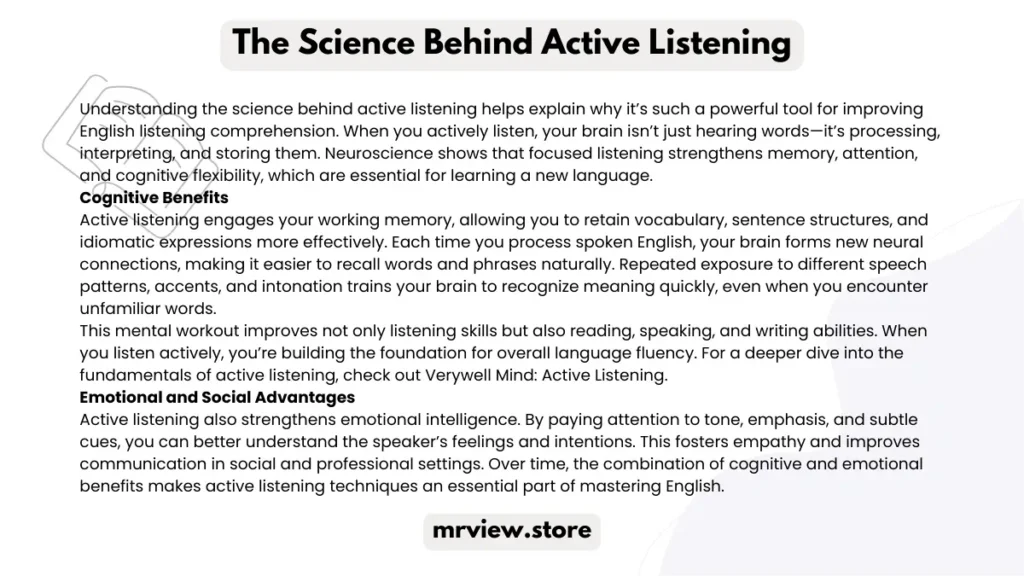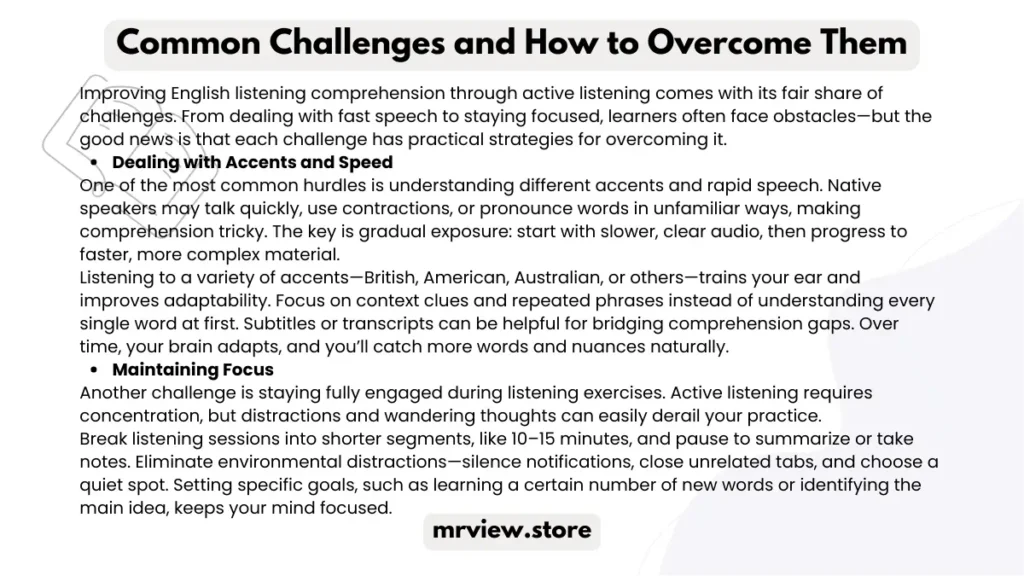Learning English can sometimes feel like trying to catch water with a sieve—you hear a lot, but retain very little. That’s where active listening comes in. Unlike passive listening, which is simply hearing words without much thought, active listening is all about engaging with the language, understanding context, and responding mentally or verbally. By honing this skill, you can dramatically improve your English listening comprehension, boost your vocabulary, and even enhance your speaking fluency without relying on endless grammar drills or rote memorization. In this article, we’ll explore how active listening techniques, practical exercises, and everyday habits can help you truly master English through listening.
Introduction
1.1 What Is Active Listening?
Active listening is more than just paying attention—it’s a conscious effort to understand and process what you hear. It involves focusing completely on the speaker or audio content, interpreting meaning, and reflecting on it. In English learning, this means not just hearing words but also grasping context, tone, and nuances. For instance, if a native speaker says, “It’s raining cats and dogs,” an active listener recognizes it as an idiom for heavy rain, rather than imagining animals falling from the sky!
Unlike passive listening, where your mind might wander or you only pick up familiar words, active listening techniques encourage engagement. You might take notes, summarize content in your own words, or even ask yourself questions about what you’ve just heard. This method doesn’t just improve comprehension; it enhances memory retention and sharpens your brain’s ability to decode complex sentences.
Moreover, active listening strengthens your overall communication skills. By paying attention to pronunciation, intonation, and stress patterns, you naturally absorb the rhythm of English, making your speech sound more natural. To explore more interactive listening activities for ESL learners, check out British Council: Listening Skills.
1.2 Why Listening Is Crucial for Learning English
Listening is the foundation of language learning. Think of it as the roots of a tree: without strong roots, the branches (speaking, reading, writing) won’t flourish. English listening comprehension is essential because it helps you internalize sentence structures, pronunciation, and common expressions. For example, hearing conversations repeatedly exposes you to everyday phrases, idioms, and collocations that textbooks often overlook.
Active listening also bridges the gap between understanding and speaking. When you truly understand what others say, you gain confidence to respond naturally, rather than translating word-for-word in your head. This not only saves time but makes your communication smoother and more authentic. Plus, listening to varied accents and speech speeds prepares you for real-life interactions, whether online, in class, or at work.
By integrating listening practice for ESL learners into your routine, you’re not just hearing English—you’re absorbing it, understanding it, and getting ready to use it effectively.
The Science Behind Active Listening
2.1 Cognitive Benefits
When it comes to learning English, active listening isn’t just about catching words—it actually rewires your brain. Neuroscience shows that focused listening improves memory, attention, and overall cognitive processing. Each time you actively engage with spoken English, your brain forms new neural connections, making it easier to recall vocabulary, sentence structures, and idiomatic expressions.
For instance, listening to podcasts, audiobooks, or conversations repeatedly helps reinforce patterns and pronunciation. Unlike passive listening, where your mind might drift, active listening techniques require you to process meaning, infer context, and mentally summarize information. This mental workout strengthens both your short-term and long-term memory, enabling you to remember phrases and expressions naturally.
Moreover, understanding nuances such as intonation, emphasis, and stress patterns enhances comprehension. Your brain learns not only the literal meaning of words but also their implied emotions and social cues. This improves your English listening comprehension and boosts confidence when engaging in conversations. If you want to explore the fundamentals of active listening in daily life, Verywell Mind: Active Listening provides insightful guidance.
In short, listening actively isn’t just a skill—it’s a mental exercise that strengthens your ability to process and retain English efficiently, making learning smoother and more intuitive.
2.2 Emotional and Social Advantages
Listening actively doesn’t just benefit your brain; it also nurtures your social and emotional intelligence. By paying full attention to speakers, you pick up on emotions, tones, and intentions, which helps you respond appropriately. This is particularly useful in English, where subtle changes in tone can completely alter meaning.
For example, noticing the difference between “I’m fine” said casually versus sarcastically allows you to interpret the speaker’s real sentiment. Developing this skill enhances empathy and strengthens relationships, whether you’re chatting with classmates, colleagues, or new friends.
Additionally, active listening techniques foster patience and reduce misunderstandings. When you focus on truly understanding others instead of thinking about your reply, you create smoother communication and a sense of connection. Over time, this not only improves your listening comprehension but also helps you become a better conversationalist in English.

Active Listening Techniques for English Learners
3.1 Preparation Before Listening
Before you even hit play on a podcast or open an audiobook, preparation sets the stage for successful active listening. Choosing the right content is key—pick materials that match your English listening comprehension level, whether it’s beginner-friendly dialogues, news segments, or intermediate podcasts. This ensures you’re challenged just enough to learn, but not frustrated to the point of giving up.
Creating a conducive environment is equally important. Find a quiet spot, eliminate distractions like your phone or background noise, and set a clear goal for the session. For instance, you might aim to catch new vocabulary, understand the main idea, or notice pronunciation patterns. Skimming transcripts or summaries beforehand can also give you a roadmap, helping you anticipate key topics and context clues.
With this preparation, your brain is primed to process and retain the content, making listening practice far more productive and effective.
3.2 During Listening
Once you start listening, engagement is everything. Active listening techniques during this phase revolve around fully immersing yourself in the audio. Take notes, jot down unfamiliar words, or highlight idioms and expressions you hear. Summarizing mentally after each sentence or paragraph reinforces comprehension and retention.
Pay close attention to accents, intonation, and rhythm. Exposure to different English listening exercises—like interviews with speakers from the UK, US, or Australia—trains your ear to recognize variations and improves your adaptability in real-life conversations. Context clues are your best friends here: if you don’t understand a word, see if the surrounding words or tone hint at its meaning.
Don’t hesitate to pause, rewind, and replay tricky sections. Repetition is a natural part of listening practice for ESL learners and helps you internalize pronunciation and sentence patterns. Tools like transcripts or subtitles can be especially helpful; for guided practice, check out British Council: Listening Skills to explore interactive exercises.
By staying attentive and actively interacting with the material, you transform passive hearing into genuine learning.
3.3 Post-Listening Activities
After finishing a listening session, the work isn’t over—post-listening activities cement your progress. Start by reviewing your notes and summarizing what you heard in your own words. This reinforces understanding and helps transfer information to long-term memory.
Discuss the content with peers or language partners, either online or in person. Explaining ideas aloud not only practices your speaking but also tests your comprehension. You can also try writing short summaries, sentences, or even mini-dialogues using new vocabulary and expressions.
Additionally, revisiting challenging sections after a day or two helps consolidate learning. Integrating these post-listening strategies into your routine ensures that your English listening comprehension grows steadily, and new words or expressions become natural parts of your vocabulary.
Common Challenges and How to Overcome Them
4.1 Dealing with Accents and Speed
One of the trickiest parts of improving English listening comprehension is grappling with different accents and fast speech. It’s easy to feel lost when a native speaker talks quickly or uses unfamiliar pronunciation. But don’t sweat it—these challenges are normal! The key is gradual exposure. Start with slower, clear audio, then slowly progress to faster, more complex conversations.
Listening to a variety of accents—British, American, Australian, and others—trains your ear and builds confidence. Focus on context clues and repeated words rather than trying to understand every single word at first. Using subtitles or transcripts can bridge gaps without breaking your flow. Over time, your brain adapts, and you’ll notice that you catch more words, phrases, and subtle nuances.
Remember, understanding fast speech isn’t instantaneous—it’s a skill honed through patience, practice, and strategic listening exercises for ESL learners.
4.2 Maintaining Focus
Staying focused during a listening session can be harder than it seems, especially when your mind wanders or distractions creep in. Active listening demands full attention, but there are practical ways to train your concentration.
Break sessions into manageable chunks—listen for 10–15 minutes at a time, then pause to summarize or take notes. Eliminate environmental distractions: silence notifications, close unrelated tabs, and choose a quiet space. You can also set clear goals for each session, like learning five new words or catching the main idea of a story.
Mindful techniques, such as repeating sentences silently or asking yourself questions about the content, help keep your brain engaged. Over time, these strategies strengthen your ability to maintain focus, making English listening practice more effective and enjoyable.

Integrating Active Listening into Daily Practice
5.1 Creating a Listening Routine
Consistency is the secret sauce for mastering English listening comprehension. Without a routine, progress can be slow and sporadic. Start by setting realistic goals—commit to 20–30 minutes of focused listening each day rather than sporadic long sessions. Short, regular practice is far more effective than occasional marathon sessions because your brain retains information better through repetition.
Integrate listening into your daily life. Listen to podcasts during commutes, audiobooks while doing chores, or English news while cooking. Even casual exposure counts if you actively engage with the content. Keep a journal to track new vocabulary, idioms, and expressions you encounter. Over time, this creates a valuable reference and helps you measure progress.
Pair listening with other skills. For instance, after a session, try speaking aloud, summarizing what you heard, or writing a brief paragraph. This reinforces comprehension and strengthens your vocabulary retention. Creating a structured routine not only improves listening skills but also builds confidence and fluency in real-life English situations.
5.2 Utilizing Technology and Resources
Technology makes active listening more accessible than ever. Apps like Duolingo, FluentU, and ELSA Speak provide interactive exercises to practice listening and pronunciation. Websites offering transcripts or subtitles help bridge comprehension gaps, especially for beginners.
Podcasts, YouTube channels, and audiobooks are invaluable resources for exposure to different accents, topics, and speaking speeds. Subscribing to content that matches your interests keeps motivation high—after all, learning is easier when it’s fun!
For structured exercises and tips, check out British Council: Listening Skills to explore interactive listening activities designed for ESL learners. Leveraging technology and diverse resources allows you to practice English listening exercises anytime, anywhere, transforming passive hearing into active skill-building.
By combining routine and resources, you can make listening a natural part of your day, accelerating your journey toward fluency.
Real-Life Applications of Active Listening
6.1 In Academic Settings
Active listening is a game-changer in academic environments. Understanding lectures, discussions, and group projects depends heavily on English listening comprehension. By focusing on the speaker’s main ideas, examples, and transitions, you can follow complex topics more easily, even when new vocabulary pops up.
Participating actively in class becomes simpler too. When you listen attentively, you can respond thoughtfully, ask relevant questions, and engage in discussions confidently. Post-lecture review of notes and summarizing key points reinforces learning and helps internalize academic language.
For structured exercises to boost comprehension in educational contexts, British Council: Listening Skills provides tailored activities for ESL learners. Incorporating these techniques ensures you not only hear the content but truly understand and retain it, making your academic journey smoother and more productive.
6.2 In Professional Environments
Active listening isn’t just for classrooms—it’s crucial in the workplace. Understanding instructions, participating in meetings, and communicating effectively with colleagues all rely on solid English listening skills. Catching subtle cues in tone, emphasis, and phrasing allows you to respond appropriately and professionally.
In meetings, for example, listening for key points rather than trying to write down everything helps you prioritize information and contribute meaningfully. When conversing with clients or coworkers from different regions, exposure to varied accents through listening exercises for ESL learners builds confidence and reduces misunderstandings.
Additionally, actively listening fosters stronger relationships. When people feel heard and understood, communication becomes smoother, and collaboration improves. Integrating active listening into your daily professional routine enhances not only comprehension but also interpersonal skills, paving the way for career growth and effective workplace communication.
FAQs
1. How can active listening improve my English skills?
Active listening strengthens English listening comprehension by training your brain to process language in real time. You internalize pronunciation, vocabulary, and sentence structures naturally. Listening actively helps you pick up idioms, expressions, and collocations that textbooks often overlook. Combining listening with note-taking, summarizing, or repeating phrases aloud boosts memory and speaking fluency. Over time, active listening bridges the gap between understanding and responding, allowing you to communicate confidently and naturally without constantly translating in your head.
2. What are some effective listening exercises for beginners?
Beginners should start with short, slow-paced audio clips such as ESL podcasts, simple dialogues, or children’s audiobooks. Using transcripts or subtitles helps catch unfamiliar words. Repeating phrases aloud, summarizing content, and asking comprehension questions are practical listening exercises for ESL learners. Gradually, move on to faster or more complex material like interviews or news segments while noting new vocabulary. Consistent daily practice, even in short sessions, steadily builds comprehension, vocabulary, and confidence.
3. How do I stay motivated to practice listening regularly?
Choose content that genuinely interests you, such as podcasts, audiobooks, or YouTube channels about hobbies, news, or stories you enjoy. Set small, achievable goals—like learning five new words or understanding the main idea per session. Mixing formats, varying accents, and celebrating milestones keeps practice engaging. Pair listening with speaking or writing exercises to notice tangible improvement. With consistent practice and enjoyable content, motivation remains high, helping you steadily improve your English listening skills.
4. Can listening to music help improve my English?
Yes! Music exposes you to natural rhythm, pronunciation, and common expressions in English. Singing along or analyzing lyrics strengthens listening skills, vocabulary, and grammar. Focus on meaning rather than understanding every word. Lyric sheets or translations help beginners connect words with context. While music doesn’t replace structured active listening exercises, it’s a fun supplement that reinforces comprehension and keeps learners engaged. Repeated exposure to songs enhances your ear for English, making real-life conversations easier to follow.
5. How do I know if I’m actively listening or just hearing?
Active listening requires conscious engagement, while passive hearing is merely perceiving sound. Signs of active listening include understanding main ideas, recognizing vocabulary and idioms, summarizing content mentally or in writing, and being able to respond appropriately. If you can replay a segment and explain it in your own words or recall key points, you’re actively listening. If words blur together and details are forgotten, your mind may be wandering. Using techniques like note-taking, repeating phrases, and reflection ensures your listening is truly active and effective for English comprehension.
Conclusion
Active listening is a cornerstone for improving English listening comprehension and achieving fluency. By fully engaging with spoken English—through focused listening, note-taking, and reflection—you naturally absorb vocabulary, sentence structures, and pronunciation patterns.
The benefits go beyond language skills, enhancing memory, cognitive abilities, and social awareness. Integrating listening practice for ESL learners into daily life, using technology, and exposing yourself to diverse accents turns passive hearing into active, meaningful learning.
Whether in academic settings, professional environments, or everyday conversations, active listening techniques help you communicate confidently, understand nuances, and respond naturally. Embracing the power of listening sets you on a clear path to mastering English, making your journey toward fluency both effective and enjoyable.

